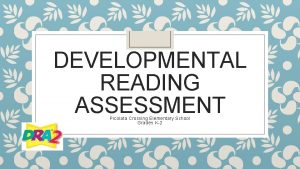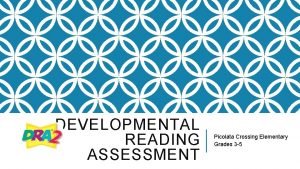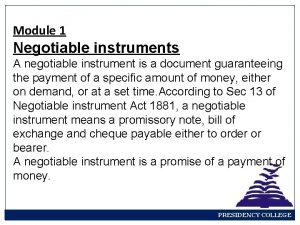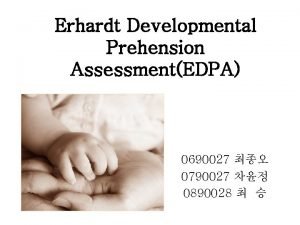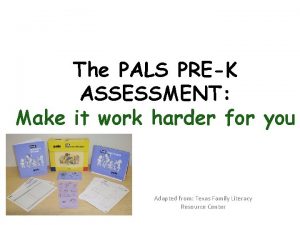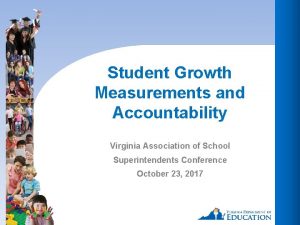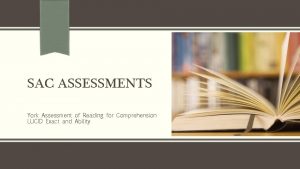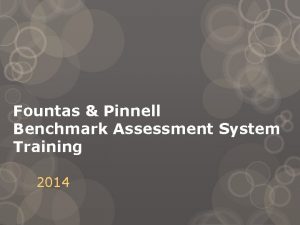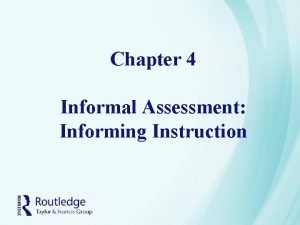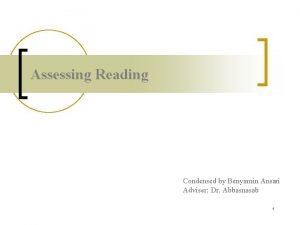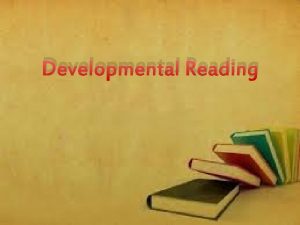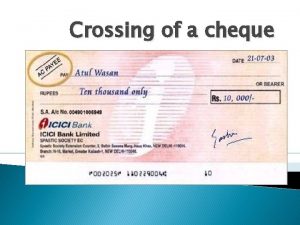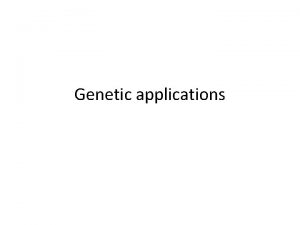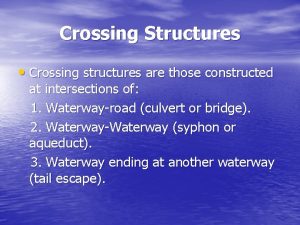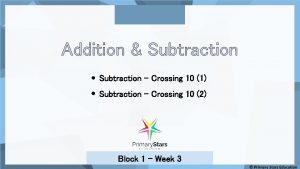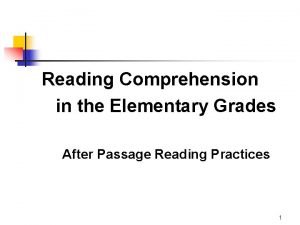DEVELOPMENTAL READING ASSESSMENT Picolata Crossing Elementary Grades 3






















- Slides: 22

DEVELOPMENTAL READING ASSESSMENT Picolata Crossing Elementary Grades 3 -5

LEARNING GOALS • Teachers will be able to administer the Developmental Reading Assessment (DRA) to determine student’s reading accuracy, accuracy fluency, fluency and comprehension • Teachers will utilize data received from the DRA assessment to drive differentiated instruction.


Students need instruction and materials at their independent and instructional levels. 85% of everything children read should be easy for them 15% should be a bit of a challenge 0% at the difficult level because it provides no purpose for learning Richard Allington 1996 So, how do we determine the independent and instructional levels of our students?


DRA ASSESSMENT CYCLE Assessing Performance Analyzing/ Reflecting Teaching/ Learning Planning Instruction

PURPOSE OF THE DRA Works in conjunction with DRA K-3 Provides classroom teachers of intermediate students -to access levels of performance on a variety of crucial skills and strategies -diagnose student needs and plan for instruction -prepare students to be successful in the classroom and on state test (FSA) -document progress across the intermediate years -keep parents informed about the levels of student achievement

BENEFITS OF DRA ØDetermines each student’s independent reading level ØConfirms or redirects ongoing instruction ØHelps teachers group students effectively for reading instruction ØDocuments changes in each student’s reading ability

DRA ASSESSMENT TOOL ØShould be administered twice a year at the intermediate level (3 for struggling readers). ØRubrics can be used with any text throughout the year ØContinuum guides instruction

ASSESSES STUDENT READING ACHIEVEMENT IN: ØWide Reading or Engagement (evidence in reading) ØSelf-evaluation and goal setting ØOral reading ØFluency ØComprehension skills and strategies

Conducting the Assessment: The Overview Step 1: Student Reading Survey (Optional) Step 2: One-on-One Student Reading Conference Step 3: Independent Student Work *For students reading DRA text Levels 20, 24, and 28 (secondgrade reading level), the teacher has two options: -Choose to have the student dictate some or all of the response in the Student Booklet. *Students reading DRA text Levels 30, 34, and 38 (thirdgrade reading level), will complete the accompanying Student Booklet independently in writing (unless the student has an I. E. P. or if writing would adversely affect the student’s level of response, the teacher may have the student dictate his or her responses for the Prediction and Summary.

READING ENGAGEMENT SURVEY While the score from this portion does NOT go into the final score to determine reading level, this survey provides valuable information to the teacher in learning more about the child as a reader.

ORAL READING FLUENCY q. While the student reads aloud the designated portion of the text, the teacher records all oral reading behaviors using the “Record of Oral Reading Guidelines”. q. It’s important to record as much as possible as it will help in analyzing the student’s reading behaviors after the test is complete. q. You will time the reading to determine the student’s oral reading fluency rate.

ORAL READING FLUENCY q. After the student reads aloud, the teacher needs to quickly count the number of miscues (self-corrections are not considered miscues) to determine if the assessment should be continued with the student or if the text is too easy or too hard. q. In order for a student to be considered independent on a level, they must score in the independent range in BOTH oral reading fluency AND comprehension.

COMPREHENSION Students respond in writing for accurate analysis Separate comprehension checks include – * Prediction * After reading response * Summary of text * Literal Comprehension * Inferential comprehension * Reflection about text * Metacognition of comprehension strategies

ADDITIONAL FEATURES DRA reflects the best practices of intermediate grade reading instruction because students – ØSelect the text they want to read according to their interests. ØUse self-assessment forms which promote reading, thinking, and writing comprehension. ØReflect on reading strategies to develop literal and inferential comprehension, summarizing skills, and metacognition.

DRA 2 WORD ANALYSIS Diagnostic assessment used with struggling and emerging readers to determine strength and weakness with spoken and written words. Intended for:

DRA ASSESSMENT RESULTS Provide teachers with: ØAn understanding of the students’ engagement in the reading process ØA fluency rate based on the timed oral reading passage ØAn oral reading score ØA comprehension score ØInsight into the meta-cognitive process

NOTES ON SCORING OF THE DRA §Teacher Guide is available in every kit to help in determining correct answers. §The Reading Engagement (survey) is not used in determining reading levels– it is purely for instructional purposes. §Students will be considered independent on the level assessed IF they score in the independent range for BOTH fluency and comprehension.

I’VE DRA’D, NOW WHAT? DRA 2 Focus for Instruction üUsing the DRA 2 Continuum, you will complete the Focus for Instruction as this will help you in forming your small groups or in conferences. üChoosing 3 -5 learning and teaching activities is useful for small group differentiation. üThe Class Profile Sheets are helpful with this as well because it gives you a “bird’s eye view” of where everyone scored in the different areas.

NEED PACKETS? Come by Room 112 in the Front Office!

If you need any further help, please contact me. I am happy to come in and model the assessment and/or assist you in scoring your tests.
 Picolata crossing elementary school
Picolata crossing elementary school Picolata crossing elementary school
Picolata crossing elementary school Sans recourse endorsement
Sans recourse endorsement Snacks crossing
Snacks crossing Snacks crossing elementary school
Snacks crossing elementary school Pre reading while reading and post reading activities
Pre reading while reading and post reading activities Joint play assessment grades
Joint play assessment grades Erhardt developmental prehension assessment pdf
Erhardt developmental prehension assessment pdf St. louis
St. louis Difference between silent reading and reading aloud
Difference between silent reading and reading aloud Types of reading skills in communication
Types of reading skills in communication Edb net section
Edb net section Process of discovery in reading
Process of discovery in reading What is extensive reading
What is extensive reading Intensive and extensive reading
Intensive and extensive reading Characteristics of intensive reading
Characteristics of intensive reading Pals score sheet
Pals score sheet Va sol vertical scaled score
Va sol vertical scaled score York assessment of reading for comprehension
York assessment of reading for comprehension Formal reading
Formal reading Benchmark assessment system reading level chart
Benchmark assessment system reading level chart Yopp-singer test of phoneme segmentation
Yopp-singer test of phoneme segmentation Selective reading examples
Selective reading examples
